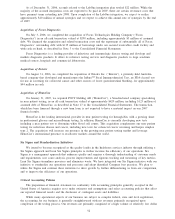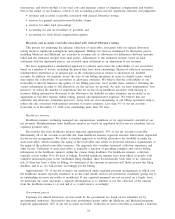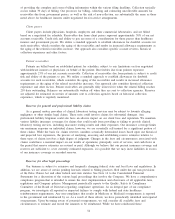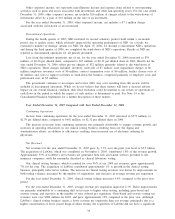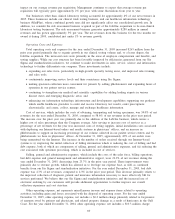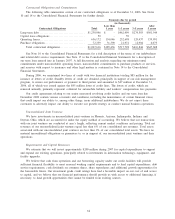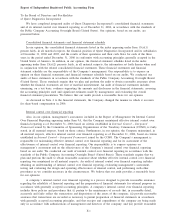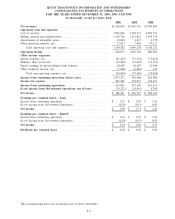Quest Diagnostics 2006 Annual Report Download - page 81
Download and view the complete annual report
Please find page 81 of the 2006 Quest Diagnostics annual report below. You can navigate through the pages in the report by either clicking on the pages listed below, or by using the keyword search tool below to find specific information within the annual report.impact on our average revenue per requisition. Management continues to expect that average revenue per
requisition will typically grow approximately 2% per year, with some fluctuations from year to year.
Our businesses other than clinical laboratory testing accounted for approximately 4% of our net revenues in
2005. These businesses include our clinical trials testing business, and our healthcare information technology
business (MedPlus), whose combined growth rates did not significantly affect our consolidated growth rate. In
addition, we consider the risk assessment business acquired as part of the LabOne acquisition to be non-clinical
laboratory testing businesses. The risk assessment business generates approximately $280 million in annual
revenues and has grown approximately 3% per year. The net revenues from this business for the two months we
owned it during 2005, contributed just under 1% to revenue growth.
Operating Costs and Expenses
Total operating costs and expenses for the year ended December 31, 2005 increased $263 million from the
prior year period primarily due to organic growth in our clinical testing volume and, to a lesser degree, the
LabOne acquisition. The increased costs were primarily in the areas of employee compensation and benefits, and
testing supplies. While our cost structure has been favorably impacted by efficiencies generated from our Six
Sigma and standardization initiatives, we continue to make investments in sales, service, science and information
technology to further differentiate our company. These investments include:
•expanding our sales force, particularly in high-growth specialty testing areas, and improved sales training
and sales tools;
•continuously improving service levels and their consistency using Six Sigma;
•making specimen collection more convenient for patients by adding phlebotomists and expanding hours of
operation in our patient service centers;
•continuing to strengthen our medical and scientific capabilities by adding leading experts in various
disease states and emerging diagnostic areas; and
•enhancing our information technology infrastructure and development capabilities supporting our products
which enable healthcare providers to order and receive laboratory test results, order prescriptions
electronically, and create, collect, manage and exchange healthcare information.
Cost of services, which includes the costs of obtaining, transporting and testing specimens, was 59.0% of net
revenues for the year ended December 31, 2005, compared to 58.6% of net revenues in the prior year period.
The increase over the prior year was primarily due to the addition of the LabOne business, which carries a
higher cost of sales percentage than the Company average. Also serving to increase cost of services as a
percentage of net revenues for the year was increased costs of testing supplies, initial installation costs associated
with deploying our Internet-based orders and results systems in physicians’ offices, and an increase in
phlebotomists to support an increasing percentage of our volume collected in our patient service centers and by
phlebotomists we have in physicians’ offices. At December 31, 2005, approximately 45% of our orders were
being transmitted via the Internet. The increase in the number of orders received through our Internet-based
systems is (i) improving the initial collection of billing information which is reducing the cost of billing and bad
debt expense, both of which are components of selling, general and administrative expenses, and (ii) reducing the
cost associated with specimen processing, which is included in cost of services.
Selling, general and administrative expenses, which include the costs of the sales force, billing operations,
bad debt expense and general management and administrative support, were 22.3% of net revenues during the
year ended December 31, 2005, decreasing from 23.7% in the prior year period. These improvements were
primarily due to revenue growth, which has allowed us to leverage our expense base, as well as continued
benefits from our Six Sigma and standardization initiatives. For the year ended December 31, 2005, bad debt
expense was 4.3% of net revenues, compared to 4.5% in the prior year period. This decrease primarily relates to
the improved collection of diagnosis, patient and insurance information necessary to more effectively bill for
services performed. We believe that our Six Sigma and standardization initiatives and the increased use of
electronic ordering by our customers will provide additional opportunities to further improve our overall
collection experience and cost structure.
Other operating expense, net represents miscellaneous income and expense items related to operating
activities, including gains and losses associated with the disposal of operating assets. For the year ended
December 31, 2005, other operating expense, net includes a $6.2 million charge primarily related to forgiveness
of amounts owed by patients and physicians, and related property damage as a result of hurricanes in the Gulf
Coast. For the year ended December 31, 2004, other operating expense, net includes a $10.3 million charge
60




